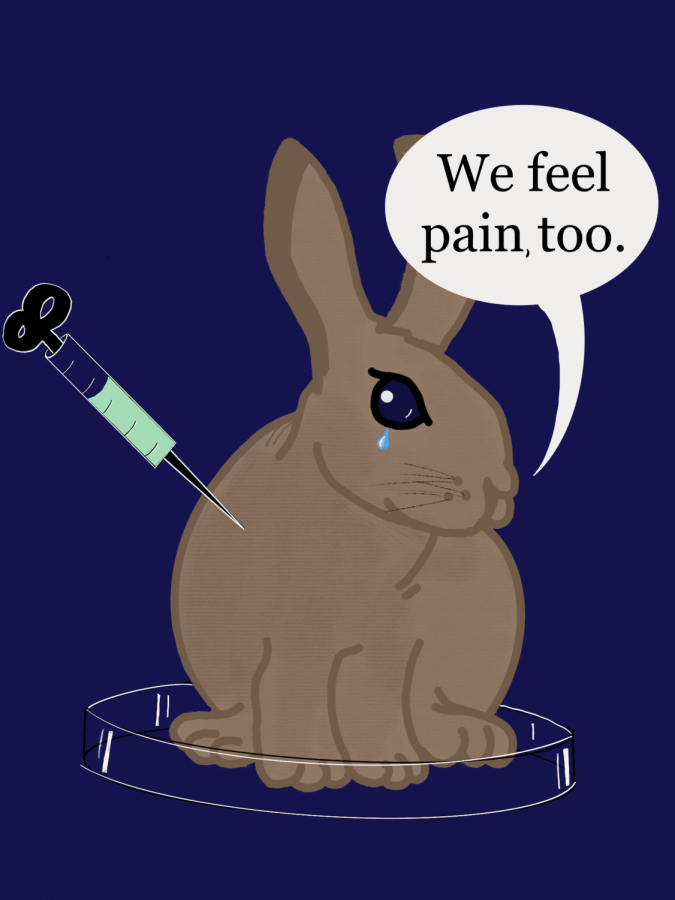Suffering upon no other
Animal testing is just another word for animal cruelty
Editorial Cartoon by Bailey Christensen
Animal testing has become the bases for animal cruelty. Animals are tested on against their will in inhumane ways such as being strapped down to a table. Laws have been put in place to put an end to animal suffrage, however, they have been proven ineffective over the years they’ve been put in place.
December 13, 2019
Animals fall victim to an inhumane practice called animal testing. These kinds of tests have been around since the time of the Ancient Greeks (384-322 BCE). Since then, it has become more common to use animals as lab rats instead of humans. Most people are blind to the fact that over 100 million animals undergo abuse from these kinds of tests. This form of testing is inhumane, doesn’t follow animal rights laws and unreliable.
Animal testing causes large levels of suffering amongst animal test subjects. According to Humane Society International, the animals who take part in testing are subjected to forced chemical exposure, infections and other wounds needed in study, along with food and water deprivation.
Many people let this kind of animal abuse slide since the Animal Welfare Act (AWA) has been set in action. However, the AWA was put in place only to standardize how nonhuman primate mammals such as dogs, cats and hamsters were maintained and obtained within a facility, not how they were used during research. This implies that scientists can do whatever experiments they wish upon a subject, and they only have to provide them with a “safe” environment when not being used in tests. Unfortunately, as stated before, the act only applies to many primate mammals (nonhuman). As stated by The Hastings Center, the act doesn’t protect rats, mice, fish, or birds, and these types of animals account for 95% of animals used in research and studies. This means that these animals are treated a lot more poorly than many mammals, meaning poorer living conditions and, even worse, the tests used on them.
Though the AWA has put more limits on animal testing, it has still failed to stop animal abuse during these tests from happening. Horrors still lurk around laboratories all across the world. In one case, according to SAEN (Stop Animal Exploitation Now), a reporter in California found a little plastic baggie on top of the counter. At first glance most people wouldn’t even bother investigating it, however, in this case, it was worth it. The reporter found three baby mice sealed shut in a baggie, still alive, and left unattended by scientists. Though these creatures aren’t protected under the AWA, this still identifies the tragedy that befalls so many other animals who are being tested on. Not only that, but this further proves that though there are laws set in place to put restrictions on the testing of animals, they still end up failing mainly due to neglection of the cause.
Knowing that animals suffer in the hands of researchers isn’t enough. It’s also important for people to know the reasons animals are tested on, and why it doesn’t always work out. Testing and research on animals are common in both the medical field and in the field of cosmetics.
In medical studies, animals are used to help develop cures for diseases such as certain forms of cancer. Though this type of research has brought us treatments for illnesses such as breast cancer, animal anatomy differs greatly from humans making this kind of testing unreliable. Animal Research.info stated that around 94% of drugs that pass animal testing have failed human clinical trials, including 85 failed HIV vaccines. Even while knowing this, researchers have continued using animals for their research, and while most of them fail we are wasting many animal lives. Not only do most tests fail, but these tests can mislead scientists into thinking they have found a cure and/or treatment when in reality they didn’t. This can cause even further damage because though they might have worked for the animal, the human anatomy is different than a rat’s, or a dog’s and it can lead to different results.
Animal testing is also used for cosmetics. The main victim that falls upon the testing of makeup is dogs. Since around the early 1900s, we have started to use chemicals within foundations, lipsticks and eyeshadow. What better subject to test on than on a poor, helpless animal strapped down to a table against their will? Many of these cosmetics tested on these canines can lead to devastating results. Most of the time the testing can lead to burned skin, or an infected eye and/or another part of the body.
Testing for medical and cosmetic research are the main types of research where most animals suffer and these scientists don’t show any sign of changing their experimental ways. However, what many people overlook are the solutions to this abuse of animals.
During the past few decades, it has become more common to tests on donating organs and human cells. According to Britannica, these alternate methods off testing provide better results that are more trustworthy than the results that come from animal testing. Yes, it may take a lot longer, but over time the innovations to these alternatives can improve providing faster and more accurate results.
Researchers have been using animals as test subjects for centuries. However, over time abuse of these animals has increased dramatically. Animal testing is not only inhumane, as the AWA help with the increasing abuse, but it’s also an unreliable source of information for cures and treatments in the medical and the cosmetology field. There are many other options out there as alternatives to the cruelty of animal testing. An end needs to be put on this kind of animal abuse and the time of action is now.







